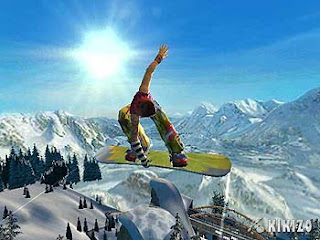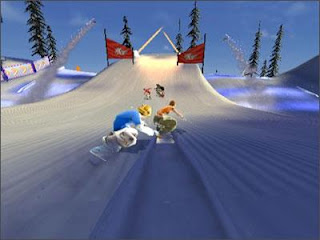 For fans of the SSX series it sure has been a long wait, with the last multi-platform title coming from all the way back in 2005 and the last entry in the franchise, SSX Blur, released all the way back in 2007 exclusively on the Nintendo Wii. With last year's reveal of a new next-gen SSX title which didn't have the best impressions from the fans, many have been left wondering if this new SSX is a return to form or just another gimmicky release. From our hands-on time with the game at E3, we can safely say that long-time fans of the series will feel right at home.
For fans of the SSX series it sure has been a long wait, with the last multi-platform title coming from all the way back in 2005 and the last entry in the franchise, SSX Blur, released all the way back in 2007 exclusively on the Nintendo Wii. With last year's reveal of a new next-gen SSX title which didn't have the best impressions from the fans, many have been left wondering if this new SSX is a return to form or just another gimmicky release. From our hands-on time with the game at E3, we can safely say that long-time fans of the series will feel right at home.The demo started off with the ability to pick the mountain range we wanted to play on. EA has crafted quite an interesting menu for the game, which uses NASA's topography data to generate the mountains and the Earth in real-time. Simply move the analog stick and you can move from one range to another. It's much more intuitive and entertaining than a generic menu system and was a great start to the demo.
We have yet to see an SSX

At the enormous EA
First, we were notified that the game was being shown off in a pre-alpha state, which is rare for an EA game at E3. The team has developed a new level generation technology which sounds unprecedented compared to any other downhill game, snowboarding-related or not. The system can take topographical information from NASA, and essentially take the input the GPS coordinates of any mountain around the world. From there, a model of the mountain consisting of at least 100,000 polygons can be constructed in only 28 seconds. So this allows for the development team to stop focusing on re-creating a mountain by hand and focus instead on crafting fun rides down the slopes. In one example given, a real-life mountain lies between the border of China and a neighboring country. The developers took a liberty with this fact and placed the Great Wall of China on this mountain, and the player can grind said wall. So essentially this level technology allows for more time for the team to stretch their creative muscles when creating courses.

Up next was the first of the core three modes of SSX
The next mode, “Trick,
Last but most certainly not least, we saw a small sample of the “Survive” mode. This is the mode that the announcement trailer was representing. The physics engine applied to the snow can do more than just accurately map a mountain based on NASA’s data. It can apply stability maps to that snow as well. What this means is that you can cause avalanches – but not all the time. This “Survive” mode starts you off near the top of mountains, the only mode that does this; according to the developer when you get near the tops of mountains the terrain is much less fun for the other modes. For example, if you carve along some snow and it comes loose, an avalanche may be triggered. If, however, there is a patch of flat, and therefore relatively stable, snow, it may end up stopping the previously dislodged snow from triggering an avalanche. In the example we saw, the player of course started an avalanche. It quickly snowballed into a level 1 avalanche and was fast approaching a level 2 before he was slammed against a cliff and the game was over. The camera took a swing to an overhead view, with the player zooming towards the bottom of the screen and mountain. It was very tense, and looks to bring a measure of excitement the series has yet to see.
After these game modes were demoed for us, we were led into another, slightly smaller room to the right. There we got our hands on the “Trick” mode to try for ourselves. The controls are a pretty standard affair – left analog stick to move the boarder, face buttons to initiate tricks. You can tweak these tricks with the right analog stick, and combing this with moving the left stick can rotate and flip your boarder. L2 is used to grind “anything pointed.” The especially well-handed among us can grab the board with the circle button, tweak it with the right stick and turn/flip with the left stick. You can pull off some great-looking tricks with relative ease, and landing is pretty simple. It’s all about timing – it doesn’t seem to matter your boarder’s orientation, as long as you release the trick at the right time you will land basically every time. After three runs I had gotten the hang of the game enough to achieve a gold medal on the level, so this is looking to be a mode that almost anyone can play.
While I would have liked to have gotten time with the other two modes, unfortunately that was not available to try here. But based on what I saw at the demo, the series seems to be headed in a good and refreshing direction. I came into the demo quite cautious, and left with a want for more time with it. Knowing the game is in a pre-alpha state and yet is already this presentable is also promising for things to come.
To start off the demo, the developers picked Mt. Kilimanjaro and chose the option to have a race towards the bottom. For fans of snowboarding games, it's well-known that those that try to be too realistic often make their game too boring while those that go for a more "cartoonish" approach often make their game seem un-lifelike. With the NASA imagery we initially thought the latter might be the case here, but once the demo started it became clear that EA
The EA Sports games started off with SSX, the return of the long-running snowboarding series to the current generation of game systems. The theater filled with fog and lights as the main screen showed a snowy mountain getting closer and closer. It turned into a trailer for SSX (one name, not SSX Snowboarding or SSX Tricky or SSX Blur). The trailer showed a lot of massive stunts and snowy vistas, but it didn't include gameplay footage, so it can't be seen as representative of the game.
However, the following presentation did detail the upcoming title. The game will focus on three modes: Race It, Trick It, and Survive It. Race It and Trick It focus on races and trick-based scoring, like in previous SSX games, and Survive It seems to involve huge stunts in survival scenarios, like running from an avalanche. The biggest feature of the game is its scope. According to the demonstrator, SSX uses NASA satellite data to allow players to drop into every major mountain range on the planet. That's an ambitious snowboard run, and it's scheduled to come out January 2012.
The second part of the demo detailed the "Deadly Descents" moniker that the game originally had in North America when the game was first revealed. Veteran character Elise was tasked with riding down the mountain as the mountain itself tried to bury her alive. This mode has the camera pan out away from the action to show off the entirety of the mountain and provided quite a neat effect when seen in action. The crux of this mode involves how the player rides down the mountain, as going for riskier routes may help scale the player farther and faster down the mountain at the risk of causing a larger avalanche or some other catastrophic event. According to the developers the dangers and obstacles will be randomly generated so each ride down the mountain will be different from the last. SSX will be released next January on the PS3 and Xbox 360.









ROBLOX is empowered by an ever growing community of over 300,000 creator players who generate an infinite variety of highly immersive experiences.
ReplyDeleteThese experiences range from 3D games and contests, to interactive adventures where players can take on new avatars to imagine what it would be like to be a dinosaur, a miner in a quarry or an astronaut out in space.